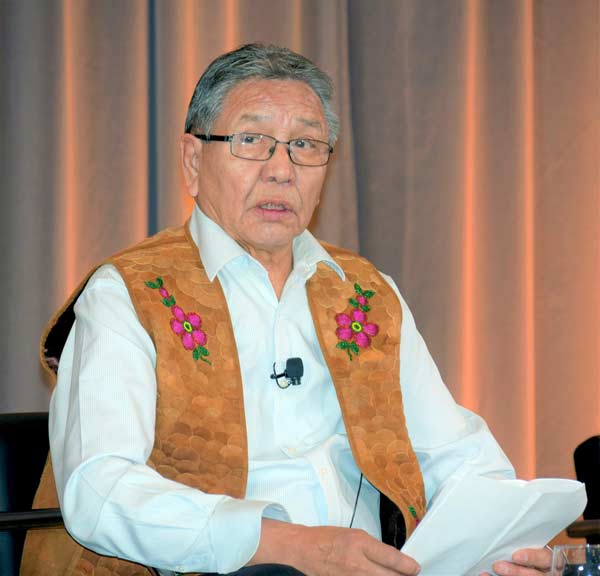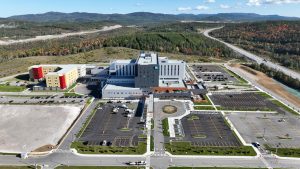Amidst all the shop talk about procurement innovation and leading-edge engineering at a remote site, it took a moving anecdote from an Indigenous community elder to remind delegates attending the recent Canadian Council for Public-Private Partnerships (CCPPP) conference why some major infrastructure projects are undertaken in the first place.
Alfonz Nitsiza, Chief of Whati, part of the Tlicho government in the Northwest Territories, joined three other stakeholders involved in the 97-kilometre Tlicho All-Season Road project in a panel discussion on day one of the CCPPP conference held in Toronto Nov. 18 and 19.
The presentation was billed as The Evolution of the P3 Model: Perspectives from the Indigenous and Development Communities at the Forefront of Change.
A poster with project details listed natural resources development, reduced cost of living and development of a strong northern workforce as project objectives. But the chief offered further insights.
Nitsiza said his community has talked about need for the all-season road to connect the community of Whati with the Yellowknife Highway for decades. Among the most vocal, he said, was his late uncle, who was chief before him.
The uncle, Nitsiza explained, had survived two plane crashes in the region.
“He was very forceful,” said the chief. “He thought it was very important to have a road coming to the community.”
The Tlicho P3 project will be delivered by North Star Infrastructure, with Kiewit Canada as the main partner and 80 per cent equity investor and the Tlicho Investment Corporation (TIC) covering the remaining 20 per cent equity. The job been touted as the first time an Indigenous community has taken a major equity role in a large project and as the delegates heard, the local Indigenous community is contributing as a full project participant with 35 per cent of the construction jobs allotted to their workers.
The P3 model is DBFM with the Government of the NWT as the project owner. Construction got underway this fall with its buildout expected in three years.
A key enabling factor in the project was the Whati self-government status, Nitsiza said. The Tlicho Investment Corporation is well established with dozens of local businesses as members but the remoteness of the community, 120 kilometres northwest of Yellowknife and accessible only by plane or ice road three months a year, limited growth.
The half-hour flight to Yellowknife costs $1,000, Nitsiza said, and the cost of freight is an exorbitant $2 per pound. Tourism in the Yellowknife area is valued at $200 million per year but in Whati it’s negligible.

Enthusiasm in the community grew after the first studies were undertaken in 2007, said Nitsiza. The locals envisaged new social, recreational, sporting and job training opportunities with the new access, he said, besides cheaper food and enhanced tourism opportunities.
“This is why we were so excited to get the road going,” Nitsiza explained.
As more consultation with stakeholders ensued and an interagency consulting group established, the local community became invested in the project and its local knowledge became an integral part of the pre-project knowledge base. Fears associated with change dissipated as the bid teams ensured there would be mitigation of any negative effects on local citizens, Nitsiza explained.
“With all this work we were satisfied this was the right time to have this road built,” said the chief.
The consulting work of the interagency group continues even now that construction has started.
TIC CEO Mark Brajer joked during his presentation that the small project team at the TIC was kept busy during extensive consultations with the three bid teams — there was full sharing of information among all parties following the dictate of the government of the NWT that the TIC could not exclude any of the teams.
There were 1,000 design engineers from Kiewit and two members of the TIC, Brajer laughed.
“At the bid time you could tell the Tlicho and the government had done a lot of work,” commented Terry Burgis, senior vice-president with Kiewit Canada and the project co. representative for North Star.
Kiewit’s Rob Cornell, project manager and design-build lead on the project, noted there were certain construction requirements imposed by the local community that forced Kiewit to be flexible as the build was designed. For example, there could be no bridge piers in the water as streams were forded.
“We had to be creative,” Cornell said.
Some skilled labour from the local community came from the mining sector, Brajer noted, given that regional diamond mines were slowing and laying off workers. Further indication of local enthusiasm is that some workers, who had been aiming to retire, have found the lure of the Tlicho road job so strong that they are postponing retirement, Cornell said.
The Kiewit team is enjoying being engaged in a project that clearly pleases the local residents so much and will leave a lasting mark, said Cornell. Any challenges are viewed through the lens of the local citizens, he explained — “This is their project.”
Said Cornell, “It is always exceptional to work on a project that is close to people’s hearts and their values.”











Recent Comments
comments for this post are closed